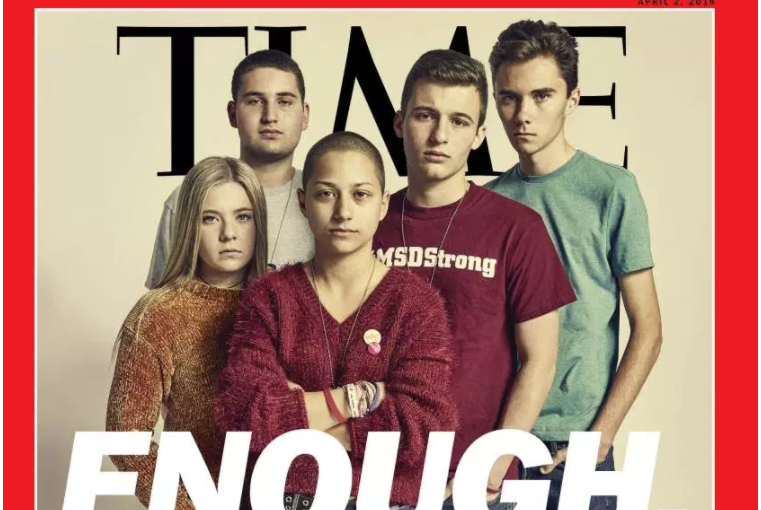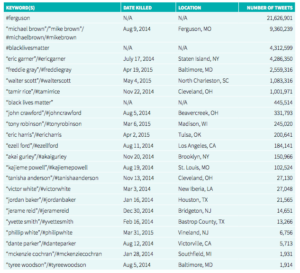Catherine Paull
Abstract
This paper explores how the surviving victims of the Marjory Stoneman Douglas (MSD) High School mass shooting have created a strong community and used social media to advocate for tighter gun control. They have formed the Never Again movement that has already gained widespread support, and organized two national events (National Walkout on March 14, and March for Our Lives on March 24). This paper examines how Web 2.0, and more specifically Twitter, has been used to form, mobilise, and maintain online communities. It also explores how social activists can use Twitter to create branding and social capital.
Introduction
“Be a nuisance where it counts. Do your part to inform and stimulate the public to join your action. Be depressed, discouraged and disappointed at failure and the disheartening effects of ignorance, greed, corruption and bad politics – but never give up.”
Marjory Stoneman Douglas (Willingham, 2018).
Marjory Stoneman Douglas was a journalist, environmentalist, activist, and had a high school named after her in Parkland, Florida USA (Willingham, 2018). Her quote was placed near MSD High School on March 14, the day of the National Walkout in North America in response to the school shooting, one month after 17 people were killed (Willingham, 2018). After the horrific event, several MSD students came together and created a movement which swept across North America, and the world, via the web. It is through the affordances of Web 2.0 that this community has been so successful. Twitter facilitated the formation, mobilisation and maintenance of the community, and without Twitter the community may not have formed.
The Never Again movement can be classified as a community of practice that formed as a result of their effective use of Twitter, and maintained through their leaders’ focus and determination. According to Katz, “the essence of the community is one of networked individualism, in which we all choose our own communities, rather than be fitted with others into them involuntarily” (Katz et. al., 2004, p.332). Through Twitter, other users have connected to the movement, and participated in debate surrounding gun reform with the leaders of the Never Again movement. A community of practice has three main features; it has a shared domain of interest, lively and active community members, and has a form of practice (e.g. sharing information, planning events, etc.) (Komorowski et. al., 2018). The Never Again movement can therefore be classified as a community of practice because of the shared interest in gun control, the community members and leaders are very active. Emma Gonzales, one of the more well-known leaders because of her passionate speech at the Fort Lauderdale Rally a few days after the shooting (Witt, 2018), created a Twitter account for the movement and has already posted 1, 653 tweets, and has over 1.5 million followers (Gonzalez, 2018). The community has a form of practice that includes sharing information, creating events (National Walk Out, March for Our Lives), and rallying against the NRA (National Rifle Association) (March For Our Lives, 2018). To understand how social activism is able to utilise the affordances of social media, this paper examines the Never Again movement, focusing on how an online community was formed, its ability to mobilise community members into real-world action, and how self-branding and social capital are used for activism.
Community formation and mobilisation
A community is a group of people connected through a common interest or topic, and it is based on the exchange of information (Katz et. al., 2004). The Never Again community was formed through the social media platform Twitter, using its hashtag tool. The hashtag #NeverAgain was created by Cameron Kasky two days after the shooting in MSD High School in Parkland, Florida (SBS News, 2018). Hashtags are a form of tagging folksonomy, which is a user-generated system of classifying information (Highfield & Leaver, 2015). Bruns and Burgess agree, and further suggest “hashtags are used to bundle together tweets on a unified, common topic,” which is why they can be useful for crisis situations, or activism movements (Bruns & Burgess, 2011, p.5). Hashtags on Twitter allow users to find tweets that are not generated by the people they already follow, and allows people who do not have Twitter accounts to also find posts (Bruns & Burgess, 2012). The #NeverAgain hashtag sparked the movement, and it quickly gained traction on Twitter, and a few days later the community was formed. According to Bruns and Burgess, “it is this very flexibility of forming new hashtag communities as and when they are needed, without restriction, which arguably provides the foundation for Twitter’s recognition as an important tool for the discussion of current events.” (Bruns & Burgess, 2011, p.7). The victims of the school shooting were standing up and talking about gun reform in a way that had never been done before. According to Dana Fisher, an expert on US social protests from the University of Maryland, the shooting happened during a period of intense political activism, which began with the Women’s March the day after President Trump’s inauguration (SBS News, 2018). Fisher argues “people are paying attention to politics like they haven’t before, including children,” and unlike the last school shooting at Sandy Hook, where 20 elementary school children and 6 staff members were killed, the students of MSD High School are older and therefore able to speak up (SBS News, 2018, “What Makes Parkland Different,” para. 3). Professor McAndrew, a mass shooting expert, argues “the ease with which social media is integrated in their lives also gives them an edge when it comes to organising and communicating with each other, as well as with the world at large” (SBS News, 2018). The cohesion of the movement is suggested to have been why it gained so much traction in such a short amount of time (SBS News, 2018).
Some scholars argue online activism is not strong enough to mobilise or sustain a movement, because these communities do not have any face-to-face communication (Harlow, 2011). Huberman et al, also argue there are two types of networks on Twitter – those that “matter” and those that do not (Huberman, Romero & Wu, 2009). The networks that matter are smaller, include people who are friends of the user offline, and they interact more frequently (Huberman, Romero & Wu, 2009). Huberman et al, argues the broader network, which reaches more people, is less influential because there is less interaction (Huberman, Romero & Wu, 200).
However, the MSD students were able to successfully mobilise their online community, and hold two significant protests offline – the National Walkout (March 14) and the March for Our Lives (March 24). According to Aguiton and Cardon, Web 2.0 platforms like Twitter highlight the importance of weak cooperation because they allow weak ties to mobilise and work together to share information (Aguiton & Cardon, 2007). This is demonstrated by the interaction and collaboration between the main organisers (the MSD students) and their weaker ties (their Twitter followers), which generated success for the two events, the Walkout and the March. The movement started online, however, the organisers effectively mobilised their community to flow offline. The National Walkout was originally planned to be a seventeen minute walkout with each minute representing a fatality in the MSD High School shooting, however, in many cities the demonstrations continued (Grinberg & Yan, 2018). According to USA Today, 2,800 schools across North America had students participating in the walkout, with some teachers joining in as well (Bacon & Hayes, 2018). It is estimated that 800,000 people marched in Washington DC on March 24 (Reilly, 2018), which demonstrates the successful mobilisation of weak ties. Marches were also held in Parkland, San Francisco, New York, Oakland, Bethel (location of 1997 school shooting where two students were killed), Newtown (location of the Sandy Hook shooting), and all around the world including Paris (The Guardian, 2018). Not only was online communication effective, it was the only way for these two events to unite students across the country in a way that has never been done before. TIME suggested “they’re the first school-shooting survivors who are old enough, angry enough, and medi-savvy enough to force the nation to grapple with a problem that adults have failed to solve” (Alter, 2018). Bruns and Hanusch argue social media platforms, like Twitter, “offer unprecedented opportunities for users to reshape public understandings of crisis events, contesting or reinforcing mainstream media frames” (Bruns & Hanusch, 2017, p. 1138). This is exactly what the MSD students, and other North American students, are successfully doing now to push back against the NRA. Twitter allowed these students to form and mobilise their online community, thereby turning it into an offline community as well.
Maintenance of the community and its message
The Never Again movement has been prolonged in the global news cycle because the MSD students have control over their message. Two core members of the Never Again campaign have tweets pinned to their Twitter account addressing the issue of others blaming or attacking political parties.
Instead they remind people to support the movement, work together, and advocate for change. After the initial reaction to the event, the MSD students narrowed the focus of their movement to a five core aims – fund research into gun violence and prevention/intervention programs, eliminate restrictions on the Bureau of Alcohol Tobacco Firearms and Explosives (ATF), universal background checks, ban on high-capacity gun magazines (magazines which hold more than ten rounds, that allow rapid firing), and a comprehensive assault weapon ban (March For Our Lives, 2018). The movement also promotes an increase of voter registration and turnout (for the upcoming midterm elections) (Alter, 2018). Instead of a generalised conversation about gun reform, the Never Again movement has centralised their message. Bastos argues social media platforms, like Twitter, “can rapidly shift between information diffusion and social network formations as users move from specialized to generic topics of conversation” (Bastos et. al., 2018, p.291). This means the centralisation of information allows more people to join the community because there is a clear topic of focus. This makes the movement more inclusive and helps appeal to Americans who do not want to give up their right to bear arms (under the Second Amendment in the Constitution).
Social capital and self-branding
This case study on the Never Again movement demonstrates how branding and social capital on Twitter can be used for social activism. Social capital is the concept of value that is associated to a person or that is constructed and reinforced by social contact, civic engagement, and a sense of community (Katz et. al., 2004). According to Katz, social capital is built through trust, which allows communities to accomplish more than any individual can (Katz et. al., 2004). It has become common practice for prominent public figures to use “self-branding” on social media to increase their social capital (Hanusch & Bruns, 2016, p. 39). The core members of the Never Again movement have effectively accomplished this using the affordances of Twitter. Four of the leaders of the Never Again movement mention their campaign, and demonstrate some aspect of their individuality through their Twitter account bio (refer to Appendix B).
Cameron Kasky brands himself as a Gryffindor (a Hogwarts house in the popular UK book series Harry Potter written by J.K. Rowling), and founder of #NeverAgain (Kasky, 2018).

Delaney Tarr brands herself as a student, an activist, and a “meddling kid” (in reference to the popular kids television show Scooby Doo) (Tarr, 2018).

David Hogg brands himself as a surfer, dreamer, reporter and activist (Hogg, 2018).

Jaclyn Corin brands herself as a “high school girl trying to save the country with her friends” (Corin, 2018).

These Twitter bios are personal, link to the Never Again movement in an effective demonstration of self-branding, and allows people to connect and relate with them. This approach by the leaders of the community builds social capital for the campaign, which influences more people to connect to the movement. In an interview with TIME, Corin suggests that without social media the Never Again movement would not have spread as effectively as it has – “social media is our weapon” (Alter, 2018). As activists, they have utilised the affordances of Twitter powerfully to promote themselves and their campaign.
Conclusion and future research
In conclusion, the Never Again movement has effectively used social media as an activism tool to promote their campaign. The MSD students are part of the generation that has been labeled narcissists by adults and stereotyped as constantly on social media. However, they are utilising the affordances of the very tools, such as Twitter and hashtags, that they are mocked for using, in order to advocate for change and lobby for tighter gun control in a way that has never been done before. According to Alter, “over the past month, these students have become the central organizers of what may turn out to be the most powerful grassroots gun-reform movement in nearly two decades” (Alter, 2018). To those who mock their movement, slander their leaders, and berate their message, Emma Gonzalez’s reply is – “we are prepared to call BS” (CNN, 2018, minute 10:35). In future studies, it will be important to evaluate how other student led social activism online will develop, and determine whether it is as widespread as the Never Again movement. However, in the near future it will be interesting to see how successful the Never Again movement is as the debate for gun control continues. The movement should be followed to determine if effective gun control measures are implemented in North America.
References
Alter, C. (2018, February 21). ‘We Just Had a Gun to Our Heads.’ The Florida Shooting Survivors Are Transforming America’s Gun Debate. Retrieved from TIME: http://time.com/5169436/florida-shooting-kids-gun-control-debate/
Aguiton, C., & Cardon, D. (2007). The Strength of Weak Cooperation: An Attempt to Understand the Meaning of Web 2.0. Communications & Strategies, 65(1). Available at: https://papers.ssrn.com/sol3/papers.cfm?abstract_id=1009070
Bacon, J., & Hayes, C. (2018, March 14). ‘We deserve better’: Students nationwide walk out in massive protest over gun violence. Retrieved from USA Today: https://www.usatoday.com/story/news/2018/03/14/thousands-students-across-u-s- walk-out-class-today-protest-gun-violence/420731002/
Barnitt, John [John_Barnitt]. (2018, March 31). Retrieved March 31, 2018, from https://twitter.com/John_Barnitt
Bastos, M., Piccardi, C., Levy, M., McRoberts, N. and Lubell, M. (2018). Core-periphery or decentralized? Topological shifts of specialized information on Twitter. Social Networks, 52, pp.282-293.
Bruns, A. & Burgess, J. (2011) The use of Twitter hashtags in the formation of ad hoc publics. In Proceedings of the 6th European Consortium for Political Research (ECPR) General Conference 2011, University of Iceland, Reykjavik.
Bruns, A. and Burgess, J. (2012). RESEARCHING NEWS DISCUSSION ON TWITTER. Journalism Studies, 13(5-6), pp.801-814.
Bruns, A. and Hanusch, F. (2016). Journalistic Branding on Twitter. Digital Journalism, 5(1), pp.26-43.
Bruns, A. and Hanusch, F. (2017). Conflict imagery in a connective environment: audiovisual content on Twitter following the 2015/2016 terror attacks in Paris and Brussels. Media, Culture & Society, 39(8), pp.1122-1141.
CNN. [CNN]. (2018, February 17). Florida student to NRA and Trump: ‘We call BS’ [Video File]. Retrieved March 28, 2018, from https://www.youtube.com/watch?v=ZxD3o-9H1lY
Corin, Jaclyn [JaclynCorin]. (2018, April 2). Retrieved April 2, 2018, from https://twitter.com/JaclynCorin
Gonzalez, Emma [Emma4Change]. (2018, March 31). Retrieved March 31, 2018, from https://twitter.com/Emma4Change
Grinberg, E., & Yan, H. (2018, March 16). A generation raised on gun violence sends a loud message to adults: Enough. Retrieved from CNN: https://edition.cnn.com/2018/03/14/us/national-school-walkout-gun-violence- protests/index.html
Harlow, S. (2011). Social media and social movements: Facebook and an online Guatemalan justice movement that moved offline. New Media and Society, 1-19. DOI: 10.1177/146144811410408
Highfield, T., & Leaver, T. (2015, January 5). A Methodology for Mapping Instagram Hashtags. Retrieved October 30, 2016, from First Monday: http://www.firstmonday.dk/ojs/index.php/fm/article/view/5563/4195#p4
Hogg, David [davidhogg111]. (2018, March 31). Retrieved March 31, 2018, from https://twitter.com/davidhogg111
Huberman, B. A., Romero, D. M., & Wu, F. (2009). Social Networks that Matter: Twitter Under the Microscope. First Monday. Volume 14 Number 1. http://firstmonday.org/htbin/cgiwrap/bin/ojs/index.php/fm/article/view/2317/2063
Kasky, Cameron [cameron_kasky]. (2018, April 2). Retrieved April 2, 2018, from https://twitter.com/cameron_kasky
Katz, J. E., Rice, R. E., Acord, S., Dasgupta, K., & David, K. (2004). Personal Mediated Communication and the Concept of Community in Theory and Practice. In P. Kalbfleisch (Ed.), Communication and Community: Communication Yearbook 28 (pp. 315-371). Mahwah, NJ: Erlbaum.
Komorowski, M., Huu, T. and Deligiannis, N. (2018). Twitter data analysis for studying communities of practice in the media industry. Telematics and Informatics, 35(1), pp.195-212
March For Our Lives. (2018). How We Save Lives. Retrieved from March For Our Lives: https://marchforourlives.com/how-we-save-lives/
Reilly, K. (2018, March 24). Here’s the Size of the March For Our Lives Crowd in Washington. Retrieved from TIME: http://time.com/5214405/march-for-our-lives-attendance-crowd-size/
SBS News. (2018, February 23). Who are the #NeverAgain teenagers pushing for US gun control? Retrieved from SBS News: https://www.sbs.com.au/news/who-are-the-neveragain-teenagers-pushing-for-us-gun-control
Tarr, Delaney [Delaney Tarr]. (2018, April 2). Retrieved April 2, 2018, from https://twitter.com/delaneytarr
The Guardian. (2018, March 25). March for Our Lives: hundreds of thousands demand end to gun violence – as it happened. Retrieved from The Guardian: https://www.theguardian.com/us-news/live/2018/mar/24/march-for-our-lives- protest-gun-violence-washington
Willingham, A. (2018, March 14). In the wave of walkouts, a quote from Marjory Stoneman Douglas becomes a rallying cry. Retrieved from CNN: https://edition.cnn.com/2018/03/14/us/marjory-stoneman-douglas-quote-walkout-trnd/index.html
Witt, E. (2018, February 19). How the Survivors of Parkland Began the Never Again Movement. Retrieved from The New Yorker: https://www.newyorker.com/news/news-desk/how-the-survivors-of-parkland-began-the-never-again-movement
This work is licensed under a Creative Commons Attribution-NonCommercial-No Derivatives 4.0 International License.
Feature Image attributed to TIME Magazine and photographer Peter Hapak.







